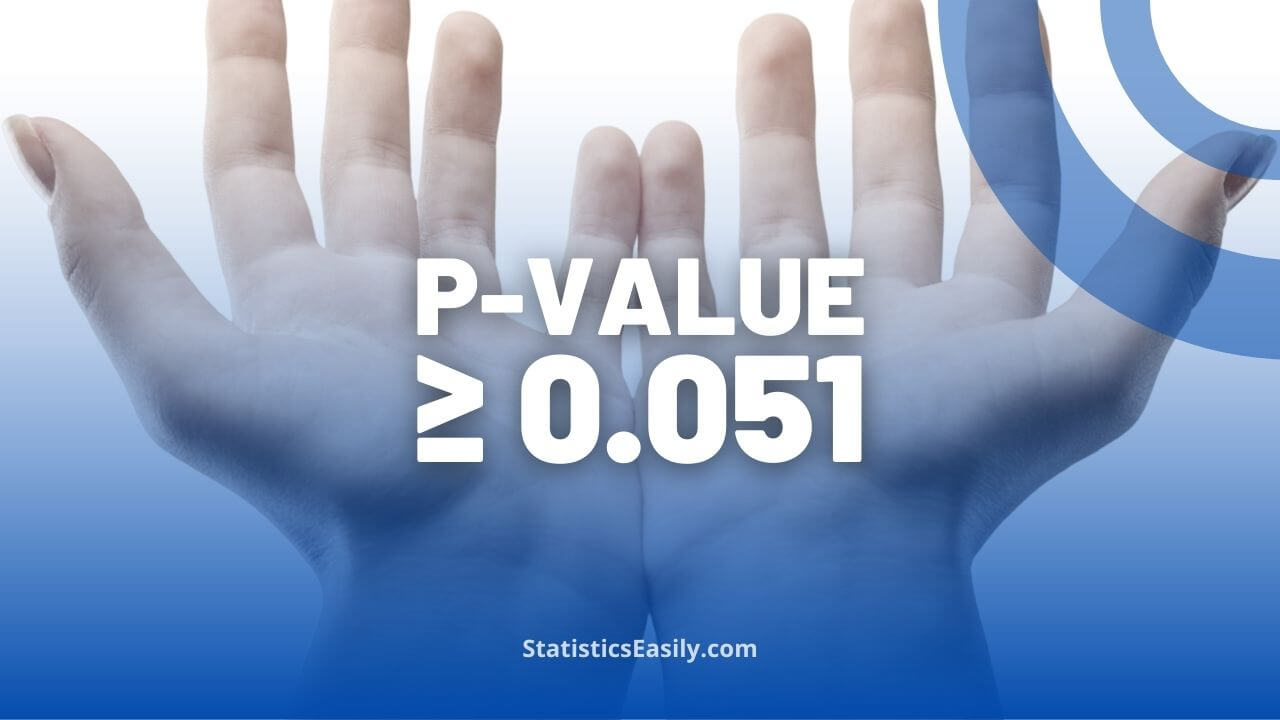Exploring the Scenario When p is 0.051 or Higher (p ≥ 0.051)
You will learn the significance of p-values, particularly when they are a “p-value greater than 0.05”, and their implications in statistical analysis and data interpretation.
Introduction
Statistical analysis is at the heart of data-driven decision-making, providing evidence to inform decisions across various fields, from healthcare to business. One key aspect of statistical analysis is the concept of hypothesis testing. Within this domain, one term stands out: the p-value. A p-value is a probability that provides a measure of the evidence against the H0 (null hypothesis) offered by the data. The null hypothesis represents a statement of no effect or difference, and it’s the hypothesis that one typically seeks to test and possibly reject in favor of an alternative hypothesis. Based on the available data, the p-value represents the likelihood of obtaining the observed data or even more extreme data, given that the H0 (null hypothesis) is accurate. In other words, it quantifies how surprising the observed data would be if the null hypothesis were correct.
Significance testing is a statistical method that uses p-values to decide whether to reject the null hypothesis. The convention in many scientific fields is to reject the H0 (null hypothesis) if the p-value is less than 0.05, often referred to as the level of significance. This threshold is chosen to balance the risks of falsely rejecting the null hypothesis (Type I error) and not rejecting a false null hypothesis (Type II error). If the p-value is < 0.05, the results are deemed statistically significant, suggesting that the observed data are unlikely under the null hypothesis.
However, a common misconception is that the p-value represents the probability that the H0 (null hypothesis) is true. This needs to be corrected. The p-value is conditional on the null hypothesis being true. It doesn’t provide direct information about the truth or falsehood of the null hypothesis itself. As discussed throughout this article, while the p-value is a valuable tool, it doesn’t tell the whole story. There are scenarios, such as when the p-value is greater than or equal to 0.051, where a more nuanced interpretation is needed. Factors like the effect size, sample size, and power of the test, among others, are essential for a more comprehensive understanding of the statistical results. In the upcoming sections, we will further investigate these considerations to provide a broader view of statistical results rather than strictly adhering to the traditional p-value threshold.
Highlights
- A p-value is a probability that helps researchers infer whether their hypothesis is supported by the data.
- The conventional threshold for statistical significance, p < 0.05, is not a strict rule and must be interpreted contextually.
- P-values slightly above 0.05 (p = 0.051) don’t necessarily invalidate a study’s findings.
- Statistical significance (p-value) and practical significance (effect size) can differ; both are important for data interpretation.
- Effect size complements the p-value by quantifying the magnitude of a phenomenon or relationship.
- Statistical power and sample size significantly influence the reliability of p-values and their interpretation.
Ad Title
Ad description. Lorem ipsum dolor sit amet, consectetur adipiscing elit.
The Standard Threshold (p < 0.05)
The concept of a p-value threshold for significance emerged as a convention in many scientific fields, with a common standard being a p-value of less than 0.05 or p < 0.05. This convention originated from the work of the eminent statistician R.A. Fisher in the 1920s. This choice of threshold is somewhat arbitrary and has been subject to debate.
The results are often deemed statistically significant when a p-value is less than 0.05. In other words, if the H0 (null hypothesis) is true, there’s less than a 5% chance that the observed data (or more extreme) would occur. As such, researchers might reject the H0 (null hypothesis) in favor of the H1 (alternative hypothesis), concluding that the observed data provide strong evidence against the null hypothesis.
However, the choice of a 0.05 threshold is not a golden rule. It represents a balance, aiming to limit the risk of two types of error:
Type I error is the incorrect rejection of a true H0 (null hypothesis — a “false positive”), and the likelihood of committing a Type I error is equal to the significance level. If we set our significance level at 0.05, we accept a 5% chance of incorrectly rejecting the null hypothesis.
Type II error — failing to reject a false H0 (null hypothesis — a “false negative”). However, the risk of Type II error is harder to quantify. It depends on several factors, including the true effect and sample sizes.
This threshold should not be considered a strict boundary between truth and falsehood. A p-value of 0.049 doesn’t fundamentally differ from a p-value of 0.051. However, they would lead to different conclusions about statistical significance if one strictly adheres to the p < 0.05 standard. Moreover, as we explore in the rest of this article, focusing solely on the p-value and disregarding other considerations, such as effect sizes and statistical power, can lead to an incomplete and potentially misleading interpretation of the data.
Scenarios with p-values Greater Than or Equal to 0.051
So, what happens when the p-value slightly exceeds our conventional threshold for significance, landing in the range of 0.051 or higher?
On the surface, a p-value greater than 0.05 might lead to the conclusion that the null hypothesis should not be rejected, implying no significant effect or difference. But as is often the case in statistics, the truth is more nuanced.
The difference between a p-value of 0.049 and a p-value of 0.051 is marginal. It doesn’t necessarily mean the former represents a ‘true’ effect while the latter does not. Therefore, the interpretation of these p-values should be guided by more than just the comparison to a threshold.
In cases where the p-value falls just above 0.05, it’s essential to examine the study design, the data, and additional metrics.
Study Design and Data Quality: Before concluding based on p-value, we must consider whether the study design was sound and the data quality was high. Potential confounding factors, biases, and other study design issues could affect the statistical results.
Effect Size and Confidence Intervals: A larger p-value could indicate a small effect size, but not always. If the effect size is large, the results might still be of practical significance even if they are not statistically significant. The confidence interval can also provide information about the range of plausible values for the effect size.
Sample Size: A smaller sample size might not have the necessary power to detect an effect, leading to a larger p-value.
Statistical Power: This refers to the ability of a test to detect an effect when there is one. A study with lower power might have a higher p-value even when an effect exists.
Multiple Testing: The probability of obtaining at least 1 false-positive increases if various hypotheses are tested. Correcting for multiple testing can result in a p-value just above 0.05, even if the raw p-value was below the threshold.
These scenarios underline the importance of a comprehensive approach to interpreting p-values and statistical results. A slightly higher p-value doesn’t automatically negate an effect or difference; instead, it invites us to look at the bigger picture.
Statistical Significance vs. Practical Significance
There is a crucial distinction between statistical and practical significance that is often overlooked in interpreting research findings.
Statistical significance refers to the chance that the observed or more extreme result could have occurred by chance, given that the H0 (null hypothesis) is true. This is where the p-value comes in. The result is typically declared statistically significant if the p-value is less than 0.05.
However, statistical significance only sometimes equates to practical significance. Practical significance means that the impact is significant enough to have practical value.
For example, a large study might find a statistically significant result with a very small p-value due to the high statistical power provided by the large sample size. However, if the effect size is tiny, the result may lack practical significance. In other words, while the result is unlikely to have occurred by chance (statistically significant), the actual difference or effect may be so small that it’s not practically meaningful or valuable.
Conversely, a study with a smaller sample size might find a larger effect that is not statistically significant (e.g., a p-value of 0.051). While the results aren’t statistically significant due to the lower statistical power of the smaller sample, the larger effect size might still be of practical importance.
This distinction highlights the importance of looking beyond the p-value when interpreting results. Effect sizes, confidence intervals, and the real-world context and implications of the result should all be considered alongside the p-value to reach a more comprehensive understanding of the findings.
A statistically significant result is not always practically significant, and a result that lacks statistical significance may nonetheless be of practical importance. Therefore, the practical significance should be evaluated to ensure that the results are statistically sound and meaningful in a real-world context.
Ad Title
Ad description. Lorem ipsum dolor sit amet, consectetur adipiscing elit.
Importance of Effect Sizes
In statistical analysis, the effect size is crucial information often overlooked. Effect size measures the magnitude of a phenomenon or the strength of a relationship in the population and is independent of sample size.
For example, in comparing two groups, the effect size might be the difference in means between the groups, which measures how much the groups differ. In a correlation, the effect size is the strength of the relationship between the variables.
While the p-value tells you whether the observed data are unlikely under the null hypothesis, the effect size gives you a quantitative measure of the magnitude of the observed effect or difference. Unlike the p-value, the effect size is not affected by sample size. A larger sample size may yield a smaller p-value for the same effect size due to the increased power of the test.
An effect can be statistically significant yet have a small effect size, which might be of little practical importance. Conversely, an effect can be large (potentially of practical importance). Still, if the study is underpowered (e.g., due to a small sample size), it may not be statistically significant.
Moreover, the effect size can be incredibly informative when the p-value exceeds 0.05. A large effect size could suggest potential practical significance even if the results are not statistically significant. Furthermore, it indicates that the observed effect or difference is substantial. It might be meaningful in a real-world context, even though the data do not provide strong evidence against the null hypothesis.
Considering the effect size alongside the p-value can provide a more comprehensive understanding of the results. While the p-value can indicate whether an effect or difference is likely to have occurred by chance, the effect size can measure the magnitude of this effect or difference, which is crucial for understanding its potential practical significance.
Power of the Test and Sample Size
Understanding the power of a test and the role of sample size is fundamental for interpreting p-values and the overall results of a study.
Statistical power is the likelihood that a test correctly rejects the H0 (null hypothesis) when the H1 (alternative hypothesis) is true. In simpler terms, the test can detect an effect when there is one. Higher power reduces the risk of a Type II error, failing to reject a false H0 (null hypothesis). Factors influencing the power of a test include the significance level, the true effect size, and, crucially, the sample size.
Sample size plays a significant role in hypothesis testing. Having larger samples helps gather more information and increases the statistical power to detect any existing effects. In addition, they can produce a smaller standard error, leading to more precise estimates and narrower confidence intervals.
However, with smaller sample sizes, studies may be underpowered, meaning they lack the power to detect an effect, even if one exists. Underpowered studies are more likely to produce a larger p-value (e.g., ≥ 0.051), not because the effect doesn’t exist but because the test lacked the power to detect it.
This is why, in scenarios where the p-value is just above the conventional threshold for significance, considering the study’s power and the sample size is vital. A non-significant result does not necessarily mean ‘no effect’ or ‘no difference,’ particularly in a smaller sample size or a low-power study.
Therefore, it’s essential to look at the p-value and consider the statistical power and the context in which the study was conducted, including the sample size. Finally, it allows for a more informed and reliable interpretation of the results, ensuring that valuable insights are not overlooked just because they failed to meet an arbitrary threshold.
Potential Biases and Errors
While p-values, effect sizes, and statistical power are crucial components of statistical analysis, it’s essential to consider potential biases and errors that may impact the results and their interpretation.
A bias is an error that can influence the outcome in a particular direction. Here are a few examples:
Selection Bias: Results can be distorted if the sample does not accurately reflect the population of interest. Considering the sampling process and whether it might have introduced any bias is essential.
Confirmation Bias: This occurs when researchers interpret or select data that support their expectations or hypotheses, overlooking data that contradicts them. It’s crucial to approach the analysis with an open mind and consider all the evidence.
Publication Bias: Studies with significant results (typically p < 0.05) are more likely to be published than those without. This can skew the published literature and impact meta-analyses.
In addition to biases, other errors might affect the p-value:
Measurement Error: Data collection errors can impact the analysis and lead to inaccurate results.
Modeling Errors: If the statistical model does not adequately represent the data or the phenomenon being studied, the results may be misleading.
Multiple Testing: Performing multiple tests increases the chance of finding a significant result by chance (Type I error). If not accounted, it can lead to a falsely significant p-value. Similarly, it can inflate p-values just above the threshold when corrections for multiple comparisons are applied.
These biases and errors underscore the importance of rigorous study design, careful data collection, and thoughtful statistical analysis. When the p-value is just above 0.05, it’s crucial to scrutinize the study for potential biases and errors that may have impacted the results. A comprehensive understanding of the study context and a careful interpretation of the p-value, effect size, and statistical power can provide a more accurate understanding of the results.
Case Studies
Let’s look at some hypothetical case studies to better understand our discussed concepts.
Case Study 1: Small Effect, Large Sample: Consider a study investigating the effect of a new educational technique on student performance. The study has a large sample size, finding a statistically significant difference in performance between students who received the new technique and those who didn’t (p = 0.04). However, the effect size is very small, indicating that the difference in performance, while statistically significant, is trivial in practical terms. This case illustrates the difference between statistical and practical significance. Finally, it emphasizes the importance of considering the effect size and the p-value.
Case Study 2: Large Effect, Small Sample: Consider a small pilot study investigating a new treatment for a rare disease. The study finds a large effect size, suggesting a substantial outcome difference between the treatment and control groups. However, the p-value is 0.051 because of the small sample size. Despite not meeting the conventional threshold for significance, the large effect size and the potential implications for patient outcomes might still make these findings of interest to the medical community.
Case Study 3: Multiple Testing: Finally, consider a genetic study investigating associations between many genetic variants and a particular disease. The study applies a correction for multiple testing to reduce the chance of false positives. Several associations that would have been significant at the 0.05 level become non-significant after the correction, with p-values just above 0.05. These findings could still be of interest as potential leads for further research.
These case studies illustrate that a p-value above 0.05 does not necessarily mean the findings are irrelevant or uninteresting. Therefore, it’s crucial to consider the broader context, including the effect size, sample size, and study design.
Best Practices in Data Analysis
Following best practices in data analysis can help researchers avoid common pitfalls and reach more reliable and meaningful conclusions. Here are some recommendations:
Consider the Effect Size: Always report and consider the effect size alongside the p-value. It measures the magnitude of the effect or difference, which is crucial for understanding its practical significance.
Statistical Power Analysis: Conduct a power analysis during the study design phase to ensure that your study has sufficient power to detect the effect of interest.
Replication and Validation: Replicate your findings with new data when possible. It increases confidence in the results.
Use Confidence Intervals: Confidence intervals provide a range of plausible values for an unknown population parameter. They provide information about the precision and uncertainty of your estimate, which can be more informative than the p-value alone.
Transparent Reporting: Be transparent about your methods, and report all results, not just the significant ones. This can help avoid issues such as p-hacking and publication bias.
Control for Multiple Comparisons: If multiple hypotheses are being tested, use appropriate methods to control the family-wise error rate or false discovery rate.
Avoid Overreliance on p < 0.05: Don’t dichotomize results as ‘significant’ or ‘non-significant’ based on the p-value alone. Consider the p-value in a broader context, including the effect size, confidence intervals, and study design.
Beware of Biases and Errors: Be mindful of potential biases and errors in your study. Rigorous study design and careful data collection can help minimize these issues.
By following these best practices, researchers can ensure a more accurate interpretation of p-values and other statistical results, producing more reliable and meaningful scientific conclusions.
Manipulating Results and Expectations
In the pursuit of reaching the magical threshold of p < 0.05, some researchers may consciously or unconsciously engage in questionable practices known as p-hacking or data dredging. This involves manipulating the data or the analysis until a statistically significant result is obtained.
P-hacking can take various forms, such as:
Selective Reporting: Only reporting statistically significant results while omitting non-significant findings.
Stopping Rules: Deciding when to stop data collection based on whether the results are significant.
Multiple Comparisons: Conducting many tests and highlighting only those that produce significant results without adjusting for multiple comparisons.
P-hacking is a severe issue as it can lead to false-positive findings, contribute to the replication crisis in science, and misguide future research and policy decisions.
On the other hand, wishful thinking refers to the tendency to interpret data based on what one hopes to see rather than what the data actually show. This cognitive bias can lead to overinterpreting findings with p-values just above the 0.05 threshold.
For instance, a researcher might be tempted to downplay the non-significance of a p-value of 0.051, arguing that it’s “almost significant” or “marginally non-significant.” Such language reflects wishful thinking and can be misleading. While it’s essential to interpret the results in a broader context, it should be done objectively without letting one’s expectations or desires influence the interpretation.
To combat these issues, researchers should pre-register their studies, specifying their hypotheses, sample size, and analysis plans in advance. They should also embrace transparency, sharing all data and results, not just the significant ones. Open science practices, such as data sharing and preprints, can help increase the transparency and reproducibility of research.
In conclusion, when interpreting a p-value, it’s essential to consider statistical significance, effect size, sample size, statistical power, potential biases and errors, and the possibility of p-hacking and wishful thinking. A nuanced and thoughtful interpretation of the results, grounded in the principles of good scientific practice, can ensure that the findings are reliable, meaningful and, ultimately, contribute to advancing knowledge.
Ad Title
Ad description. Lorem ipsum dolor sit amet, consectetur adipiscing elit.
Conclusion
In scientific research, interpreting results requires more than checking whether a p-value crosses a threshold. While useful in some circumstances, the traditional cut-off of p < 0.05 should not be the sole criterion for determining the value or significance of research findings.
It’s crucial to recognize that a p-value just above 0.05, like p ≥ 0.051, doesn’t automatically render findings irrelevant or uninteresting. In fact, these findings could potentially lead to valuable insights and future research directions. To ensure a robust interpretation of such results, it’s vital to consider the broader context, including the effect size, statistical power, sample size, potential biases and errors, and the risk of p-hacking and wishful thinking.
In particular, paying attention to the effect size can help determine whether the observed effect has practical significance, even if it doesn’t meet the conventional threshold for statistical significance. Meanwhile, considering the power of the test and the sample size can help distinguish between ‘no effect’ and ‘an effect that the study was underpowered to detect.’
Additionally, being mindful of potential biases and errors, such as selection bias, confirmation bias, and multiple testing, can aid in a more reliable interpretation of the p-value and the overall study results.
This comprehensive approach to interpreting scientific findings moves beyond a rigid adherence to a p-value threshold. It promotes a more nuanced understanding of the data. It aligns with the principles of good scientific practice. It helps ensure that the conclusions drawn are reliable and meaningful and contribute to advancing knowledge.
Recommended Articles
Interested in further deepening your understanding of p-values and statistical analysis? Take advantage of other relevant articles on our blog!
- When is P Value Significant?
- What Does The P-Value Mean?
- What Does The P-Value Mean? Revisited
- P-values and significance (External Link)
- When The P-Value is Less Than 0.05
- A Guide to Hypotheses Tests (Story)
- When is P Value Significant? (Story)
- Understanding P-Values (Story)
Frequently Asked Questions (FAQs)
A p-value is a probability that helps researchers infer whether their hypothesis is supported by the data.
A p-value of 0.051 suggests that the observed or more extreme data will likely occur 5.1% of the time under the null hypothesis.
The p < 0.05 threshold is traditionally used to control the Type I error rate (false positive) in hypothesis testing.
Statistical significance pertains to the p-value, while practical significance relates to the effect size or the real-world impact of the findings.
The effect size is a quantitative measure of the magnitude of a phenomenon or relationship.
A higher statistical power or larger sample size increases the chances of detecting a true effect, thus influencing the obtained p-value.
P-hacking involves manipulating the data or analysis until a statistically significant result is obtained, which can lead to false-positive findings.
Wishful thinking refers to interpreting data based on what one hopes to see rather than what the data actually show.
These include considering effect size, conducting power analysis, replicating findings, using confidence intervals, and avoiding overreliance on p < 0.05.
Interpreting a p-value should consider the broader context, including the effect size, confidence intervals, and study design.








